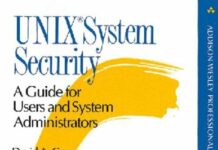| Book Name: | Cryptography’s role in securing the information society |
| Category: | Information Security |
| Free Download: | Available |
Cryptography’s role in securing the information society

For every opportunity presented by the information age, there is an opening to invade privacy and threaten the security of the nation, U.S. businesses, and citizens in their private lives. The more information transmitted in computer-readable form, the more vulnerable we become to automated spying. It’s been estimated that some 10 billion words of computer-readable data can be searched for as little as $1. Rival companies can glean proprietary secrets . . . anti-U.S. terrorists can research targets . . . network hackers can do anything from charging purchases on someone else’s credit card to accessing military installations. With patience and persistence, numerous pieces of data can be assembled into a revealing mosaic. Cryptography’s Role in Securing the Information Society addresses the urgent need for a robust national policy on cryptography that promotes and encourages the widespread use of this powerful tool for protecting the information interests of individuals, businesses, and the nation as a whole while respecting legitimate national needs of law enforcement and intelligence for national security and foreign policy purposes. This book comprehensively examines cryptography—the representation of messages in code—and its transformation from a national security tool to a key component of the global information superhighway. The committee enlarges the scope of policy options and offers specific conclusions and recommendations for decision-makers. Cryptography’s Role in Securing the Information Society explores how all of us are affected by information security issues: private companies and businesses, law enforcement and other agencies, and people in their personal lives. This volume takes a realistic look at what cryptography can and cannot do and how the forces of supply and demand have shaped its development. How can a business ensure that employees use encryption to protect proprietary data but not to conceal illegal actions? Is encryption of voice traffic a severe threat to legitimate law enforcement wiretaps? What is the systemic threat to the nation’s information infrastructure? These and other thought-provoking questions are explored. Cryptography’s Role in Securing the Information Society provides a detailed review of the Escrowed Encryption Standard (known informally as the Clipper chip proposal), a federal telephonic standard promulgated in 1994 raised nationwide controversy over its “Big Brother” implications. The committee examines the strategy of export control over cryptography. Although this tool has been used for years in support of national security, it is increasingly criticized by vendors subject to federal export regulations. The book also examines other less well-known but critical issues in national cryptography policy, such as digital telephony and the interplay between international and national issues. The themes of Cryptography’s Role in Securing the Information Society are illustrated throughout with many examples — some alarming and all instructive — from the worlds of government and business as well as the international network of hackers. This book will be of critical importance to everyone concerned about electronic security: policymakers, regulators, attorneys, security officials, law enforcement agents, business leaders, information managers, program developers, privacy advocates, and Internet users.
Book Description
This book comprehensively examines cryptography – the representation of messages in code and its transformation from a national security tool to a critical component of the global information superhighway.
It addresses the need for a robust national policy on cryptography that protects the information interests of individuals and businesses while respecting the needs of law enforcement and intelligence for national security and foreign policy purposes.
About the Authors
Kenneth W. Dam and Herbert S. Lin, Editors, Committee to Study National Cryptography Policy, National Research Council.
Cryptography’s role in securing the information society PDF
Author(s): Kenneth W. Dam, Herbert S. Lin (editors)
Publisher: National Academy Press, Year: 1996
ISBN: 0309054753, 9780309054751









![[PDF] Draw Buildings and Cities in 15 Minutes Draw Buildings and Cities in 15 Minutes pdf](https://www.freepdfbook.com/wp-content/uploads/2021/06/Draw-Buildings-and-Cities-in-15-Minutes-218x150.jpg)








![[PDF] Digital Image Processing An Algorithmic Introduction Using Java Digital Image Processing An Algorithmic Introduction Using Java](https://www.freepdfbook.com/wp-content/uploads/2022/06/Digital-Image-Processing-An-Algorithmic-Introduction-Using-Java.jpg)




![[PDF] 43 Years JEE ADVANCED + JEE MAIN Chapterwise & Topicwise Solved Papers 43 Years JEE ADVANCED (1978-2020) + JEE MAIN Chapterwise & Topicwise Solved Papers Physics PDF](https://www.freepdfbook.com/wp-content/uploads/2022/03/43-Years-JEE-ADVANCED-1978-2020.jpg)

![[PDF] Problems in Physical Chemistry for JEE (Main & Advanced) Problems in Physical Chemistry for JEE (Main & Advanced) Free PDF Book Download](https://www.freepdfbook.com/wp-content/uploads/2022/03/Problems-in-Physical-Chemistry-for-JEE-Main-Advanced.jpg)
![[PDF] Engineering Physics (McGraw Hill)](https://www.freepdfbook.com/wp-content/uploads/2021/05/bafc8c2685bb6823a9c56134f7fba5df.jpeg)

![[PDF] Engineering Chemistry By Shashi Chawla](https://www.freepdfbook.com/wp-content/uploads/2022/05/Theory-And-Practicals-of-Engineering-Chemistry-By-Shashi-Chawla-free-pdf-book.jpeg)
![[PDF] Chemistry: An Introduction to Organic, Inorganic & Physical Chemistry Chemistry: An Introduction to Organic, Inorganic & Physical Chemistry](https://www.freepdfbook.com/wp-content/uploads/2022/04/Chemistry-An-Introduction-to-Organic-Inorganic-Physical-Chemistry.jpg)
![[PDF] Essentials of Physical Chemistry Essentials of Physical Chemistry Free PDF Book by Bahl](https://www.freepdfbook.com/wp-content/uploads/2022/04/Essentials-of-Physical-Chemistry-bahl.jpg)
![[PDF] Biological control of plant-parasitic nematodes: soil ecosystem management in sustainable agriculture Biological control of plant-parasitic nematodes: soil ecosystem management in sustainable agriculture](https://www.freepdfbook.com/wp-content/uploads/2022/05/Biological-control-of-plant-parasitic-nematodes-soil-ecosystem-management-in-sustainable-agriculture.jpg)
![[PDF] Human Anatomy: Color Atlas and Textbook Human Anatomy: Color Atlas and Textbook Free PDF Book](https://www.freepdfbook.com/wp-content/uploads/2022/05/Human-Anatomy-Color-Atlas-and-Textbook.jpg)
![[PDF] Concepts of Biology Book [Free Download]](https://www.freepdfbook.com/wp-content/uploads/2022/05/Concepts-of-Biology.jpg)
![[PDF] Essentials of Biology [Free Download] Essentials of Biology Free PDF BOok Download](https://www.freepdfbook.com/wp-content/uploads/2022/05/Essentials-of-Biology-Free-PDF-Book-Downlaod.jpg)
![[PDF] Human Biology Book [Free Download]](https://www.freepdfbook.com/wp-content/uploads/2022/05/PDF-Human-Biology-Book-Free-Download.jpg)


